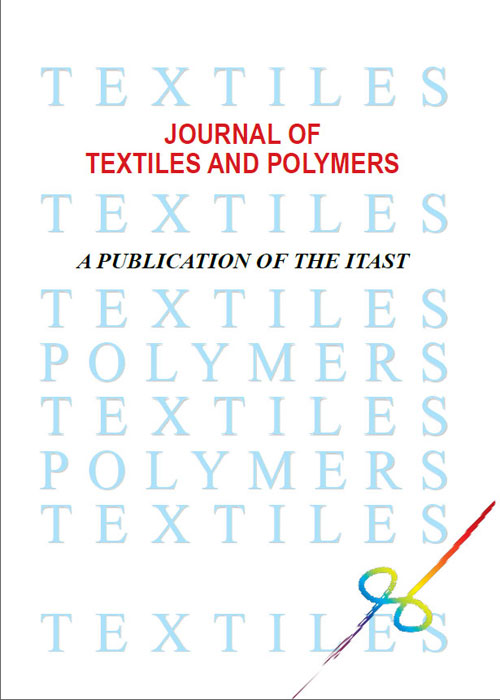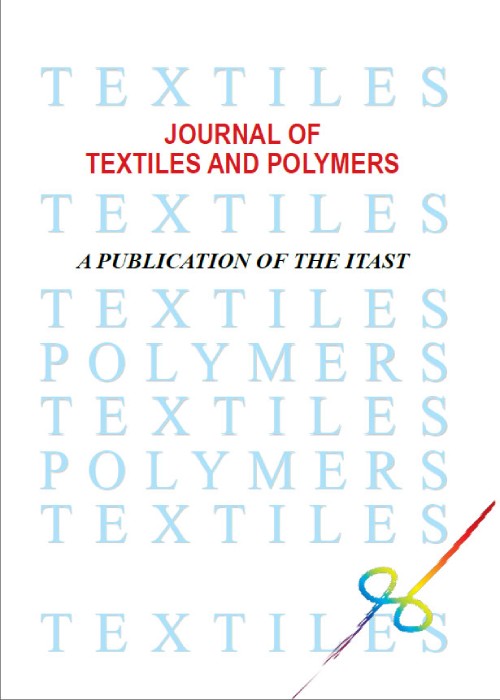فهرست مطالب

Journal of Textiles and Polymers
Volume:5 Issue: 1, Winter 2017
- تاریخ انتشار: 1395/12/07
- تعداد عناوین: 7
-
-
Pages 1-7In the present study, genetic programming (GP) as a completely different approach in comparison with conventional methods, based on the imitation of natural evolution of living organism is proposed for the prediction of cellulose acetate (CA) polymeric membrane characteristics. The membrane preparation parameters of polymer concentration, additive concentration and coagulation bath temperature (CBT) were considered as model input parameters. GP model was developed to predict the pure water permeate flux of CA membranes based on the experimental data of a membrane pilot-scale system. Some statistical parameters were considered and calculated to investigate the reliability and accuracy of the proposed model. The model excellent general performance with R2=0.98 and the low error values confirmed the accuracy of the model. According to the results, GP has displayed the potential to be used as a reliable tool for identifying the characteristics of CA membranes.Keywords: cellulose acetate, genetic programming, membrane preparation, modeling
-
Pages 8-16This article is a perspective that includes an introduction to nanofibers, nanofiber production methods, and the scale up of nanofiber production. It has been proven that nanofibers have huge application potentials in diverse areas. Therefore, many attempts have been made to scale up the nanofibers production in the recent decade. In most cases, mass production involved the use of arrays of nozzles. The production rates of these designs were limited by the spacing between jets or nozzles and the electric field interference that occurs when the jets are too close to each other. Several researchers have tried to mass-produce nanofibers by using a free surface of polymer solution, including electrospinning based on a two-layer system, bubble electrospinning, spider spinning, ball electrospinning, disc electrospinning, cleft electrospinning, porous tube electrospinning, porous electrospinning with drilled hole, ring electrospinning, stepped pyramid stage, wire electrode, and etc. Among them, the most successful one which has the ability to produce nanofibers on a large scale is spider spinning. In addition, more recently some works on mass production were based on utilizing other forces rather than electrostatic force. In this case, centrifuge spinning is a viable alternative for mass production of nanofibers. Also, some other works used a secondary force to assist electrostatic force such as magnetic force aided method, air-flow force aided method and centrifugal force aided method. The examples illustrated herein have shown that free surface electrospinning as well as hybrid electrospinning can be promising technologies for the mass production of continuous polymeric nanofibers.Keywords: centrifugal spinning, hybrid electrospinning methods, multi-nozzle electrospinning, nanofibers, needleless electrospinning, scale-up
-
Pages 17-24Using fibers to reinforce bitumen is relatively a new method to improve mechanical properties of asphaltconcrete (AC). Economical competitive advantages, ease of use and improvement of physical and mechanical properties are the benefits of reinforcing AC with fibers in comparison with other modifiers, e.g. polymers. This paper investigates the adhesion of aggregates to fiber-reinforced bitumen. This concept has been described in two parts including theoretical and experimental sections. In the former section, pull-out force of aggregate through fiber-reinforced bitumen has been modeled by using "force-equilibrium method" and "slippage theory of short fiber composites". Therefore, the adhesion force between aggregate and fiber-reinforced bitumen was obtained based on fiber parameters. In the later section, polypropylene (PP) and polyester (PET) fibers of 12 mm length, at fiber content of 0.1%, 0.2% and 0.4% were used to reinforce bitumen. Both of lime and quartz aggregates were considered in the experimental design. Consequently, the Instron tensile tester was modified to perform pull-out tests. Pull-out test measured the force required to pull-out the aggregate through the bitumen and/or fiber-reinforced bitumen. The experimental results showed that the proposed model could predict the pull-out force of fiber-reinforced bitumen samples.Keywords: asphalt concrete, bitumen, fiber, pull-out method, reinforcement
-
Pages 25-30In civil engineering applications, geogrid materials are widely used to reinforce retaining walls, roads, highways, and railway ballasts. Therefore, studying the geogrid-soil interaction under pullout condition is important for any successful design.
In this work, five types of geogrid samples with various aperture dimensions were produced and used for conducting pull-out tests. Four types of soils with different particle size distribution (PSD) and grading were used for this purpose. It was found that aperture dimension is an influential factor in the pull-out resistance (POR) of geogrids and should be selected properly based on the PSD of the soil. Soil grading was also found to be an important factor in selecting aperture dimensions. It was observed that POR is more sensitive to transverse rib density of geogrids rather than their longitudinal rib density.Keywords: aperture size, interaction, geogrid, particle size, pull-out, soil -
Pages 31-36In this work, the kinetic and thermodynamic parameters of acid dyes on nylon 6 were studied. Acid Sky Blue A, Acid Naphtol Red 6B, and Chrysophenine GX were applied on nylon6 and the dyeing process was conducted at specific conditions. In the early stages of dyeing the linear curve of percentage exhaustion against square root of time was plotted and the ratio of the second root of diffusion coefficient to fiber radius was obtained. Chrysophenine GX with a very high molecular weight, showed the maximum rate of diffusion, and exhaustion, and the lowest time of halfdyeing compared with Acid Sky Blue A and Acid Naphtol Red 6B. Also, adsorption isotherm of the dyes was investigated. The Langmuir type of adsorption was observed for Acid Sky Blue A, while in the case of Acid Naphtol Red 6B and Chrysophenine GX, Freundlich model of adsorption was obtained. The standard affinity of the dyes was calculated from the partition ratio, and Acid Sky Blue A showed the maximum value of standard affinity.Keywords: acid dyes, adsorption isotherm, nylon6, standard affinity, time of half-dyeing
-
Pages 37-47Thiolfunctionalized silica nanoparticles (SiO2 SH) were prepared by sol-gel method through using 3mercaptopropyltrimethoxysilane and nanosized silica. The effect of the pH of the silane solution on grafting efficiency of silica nano-particles was scrutinized. It was found that the reaction between silane and silica nanoparticles was more effective at low pH. The FTIR spectroscopy and CHNS analyses were used to study the chemistry of the modified nanoparticles. It was found that the SiO2SH groups could effectively remove the heavy metal ions (Pb2, Ni2, and Hg2) in the solution through electrostatic and chemical interactions. The adsorption isotherm and adsorption capacity of the functional nanoparticles for different metal ions, and its selectivity were investigated. Similarly, the effect of the pH values on the adsorption of metal ions was studied. The strong adsorption ability of SiO2SH can be attributed to the functional nonoparticles with rich thiol groups facilitating the mass transport of metal ions to the active sites. These functional nanoparticles were blended in poly(ether sulfone) membranes as an adsorbent to improve the membranes separation and selectivity properties for removal of heavy metal ions.Keywords: adsorption, functionalization, heavy metal, mercapto silane, poly(ether sulfone) membrane, silica nanoparticle
-
Pages 48-55Needle-Punching process is a mechanical method by which entanglement of fibrous webs can be enhanced. Fiber entanglement together with fabric weight can be held responsible for the variations in the mechanical properties of nonwovens. In this work, mean fiber orientation angle and fabric weight measurements were used for prediction of bending and tensile properties of needlepunched fabrics. Samples of needled nonwoven fabrics in four groups with different fabric weights were produced using appropriate carding/cross-lapping machines. The samples of each weight group were needled at various punch densities and needle penetration depths. The orientation of the fibers in the samples was determined using Radon transform method. Bending stiffness and breaking strength of the samples in both machine-direction and cross-machine direction were determined using two simply supported beam system and strip method, respectively. The results indicated that an increase in the amount of punch-density generally leads to variation in orientation angle of the fibers in the samples. It was observed that an increase in the amount of punch-density led to an increase in mean fiber orientation angle in all samples along the machine-direction. This is due to the displacement of the fibers by the needling process. Additionally, fiber orientation pattern of the samples enormously changed due to the changes in needle penetration depth. Multiple regressions based on least square method were used to estimate the mechanical properties of needlepunched fabrics. The results pointed to the paramount importance of the degree of fiber orientation and fabric weight as two influential factors controlling the mechanical properties of needle punched fabrics.Keywords: bending modulus, breaking strength, fabric weight, mean fiber orientation angle, Radon transformation


